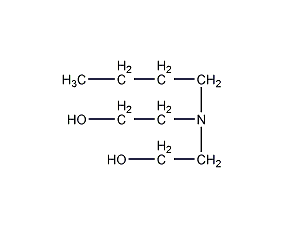
Structural formula
| Business number | 02MG |
|---|---|
| Molecular formula | C8H19NO2 |
| Molecular weight | 161.24 |
| label |
N-bis(2-hydroxyethyl)butylamine, C4H9N(CH2CH2OH)2, 2,2′-Butyliminodiethanol, N,N-Bis(2-hydroxyethyl)butylamine, Multifunctional solvents, aliphatic compounds |
Numbering system
CAS number:102-79-4
MDL number:MFCD00002856
EINECS number:203-055-0
RTECS number:KK0525000
BRN number:1739642
PubChem number:24851880
Physical property data
1. Properties: colorless or yellow liquid with slight ammonia smell.
2. Density (g/mL, 20/20℃): 0.986
3. Relative vapor density (g/mL, air=1): 5.5
4. Melting point (ºC): <−70
5. Boiling point (ºC, 98.8KPa): 273~275
6. Refractive index (20ºC): 1.462
p>
7. Flash point (ºC, opening): 118
8. Viscosity (mPa·s, 25ºC): 55
9. Viscosity (mPa·s, 60ºC): 10.6
10. Volume expansion coefficient (K-1): 0.00077
11. Vapor pressure (mmHg, 25ºC): 1
12. Solubility: Soluble in water, methanol, ethanol, ether, acetone, aromatic hydrocarbons and oleic acid, etc., insoluble in linseed oil, cottonseed oil, mineral oil and paraffin, etc.
Toxicological data
Acute toxicity:
Oral LD50 4250mg/kg (rat)
Main irritant effects:
On the skin: on the skin and mucous membranes Causes corrosive effects
On eyes: Strong corrosive effects
Sensitization: No known sensitizing effects.
Ecological data
General remarks
Water hazard class 1 (German regulations) (self-assessment via list) The substance is slightly hazardous to water.
Do not allow undiluted or large amounts of product to come into contact with groundwater, waterways, or sewage systems
Do not discharge materials into the surrounding environment without government permission.
Molecular structure data
1. Molar refractive index: 45.90
2. Molar volume (cm3/mol): 162.8
3. Isotonic specific volume (90.2K ): 409.5
4. Surface tension (dyne/cm): 40.0
5. Dielectric constant:
6. Dipole moment (10-24cm3):
7. Polarizability: 18.19
Compute chemical data
1. Reference value for hydrophobic parameter calculation (XlogP): 0.1
2. HydrogenNumber of bond donors: 2
3. Number of hydrogen bond acceptors: 3
4. Number of rotatable chemical bonds: 7
5. Tautomerism Number of bodies: None
6. Topological molecule polar surface area 43.7
7. Number of heavy atoms: 11
8. Surface charge: 0
9. Complexity: 72.5
10. Number of isotope atoms: 0
11. Determine the number of atomic stereocenters: 0
12. No Determine the number of atomic stereocenters: 0
13. Determine the number of chemical bond stereocenters: 0
14. Uncertain number of chemical bond stereocenters: 0
15. Number of covalent bond units: 1
Properties and stability
Avoid contact with oxidants, acids, and water.
Storage method
Store in a cool, ventilated warehouse. Keep away from fire, heat and water sources. Protect from direct sunlight. Keep container tightly sealed. They should be stored separately from oxidants and acidic substances, and avoid mixed storage. Equipped with the appropriate variety and quantity of fire equipment. The storage area should be equipped with emergency release equipment and suitable containment materials.
Synthesis method
Refining method: vacuum distillation and refining.
Purpose
Used as a solvent.

 微信扫一扫打赏
微信扫一扫打赏

